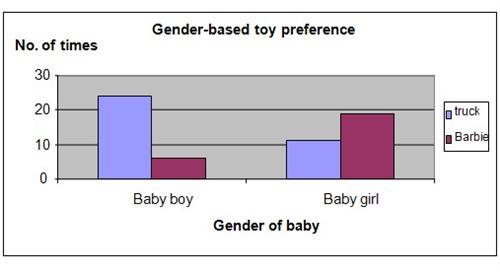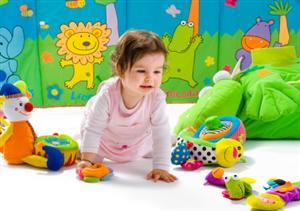| Complexity level: | 9 |
| Project cost ($): | 30 |
| Time required: | 1 day to prepare, 2 days for science fair project |
| Material availability: | Easily found at a toy store |
| Safety concerns: | Ensure that babies are handled with care, by qualified day care center staff |
Hypothesis
Baby boys will prefer trucks and baby girls will prefer Barbie dolls.
Overview
Baby’s gender and preferences
Babies as young as 6 months are believed to be unable to differentiate the gender of others around them. However some studies have shown that baby girls prefer Barbie dolls and baby boys prefer trucks. Some researchers believe that this could be due to the baby’s exposure to sex hormones when they were still in the womb.
Some of the characteristics of baby boys are that they like to see moving things and they are also more hyperactive like kicking and wiggling more often than baby girls. The baby boys are also more emotional and get agitated more easily. However baby boys are less startled by sudden noises compared to baby girls.
As for the baby girls, they are very good at copying and mimicking. They are also better at using their hands and learn to use utensil and pick up toys faster. Baby girls also learn to make eye contact faster and are more attracted to women’s faces. Baby girls are much attuned to sounds, especially human voices and they also learn to speak faster.
Scientific Terms
Materials
The materials required for this science fair project:
- Permission from a daycare center to conduct science fair project. Parental consent forms will need to be handed out and signed.
- 10 baby girls (4 to 6 months old)
- 10 baby boys ( 4 to 6 months old)
- 1 Barbie doll
- 1 toy truck
- 1 curtain
- 1 stop watch
- an assistant to watch the time
- a day care center worker to help handle the babies
Procedure
1. For this science fair project, the independent variable is the gender of the baby. The dependent variable is whether the baby takes to trucks or Barbie dolls. This is determined by observing the movement of the baby’s eyes for 10 seconds and ascertaining whether the baby prefers to gaze upon the truck or the Barbie doll. The constants (control variables) are the length of time the babies are allowed to look at the toys and the age of the babies.
2. Permission is obtained from the day care center administration to do this science fair project with the babies. The purpose of the science fair project and the procedure used is explained to the administration. The assistance of one of the day care workers is required to help handle the babies.
3. 10 baby girls and 10 baby boys are selected, aged between 4 and 8 months.
4. The babies are brought into the room to be tested one at a time. The day care worker will handle the baby. The assistant holds the curtain 1.5 meters in front of the babies. The toy truck and Barbie doll are placed a meter apart behind the curtain. Ensure that the baby is carried and held squarely in between the truck and the doll.
5. The curtain is removed and the stopwatch started. For the next 10 seconds, the baby’s eye movements are observed to see which toy the baby prefers to look at. After 10 seconds the curtain is closed. The observation is recorded in the table below.
6. The position of the toys is changed and procedure 5 is repeated.
7. The position of the toys is changed again and procedure 5 is repeated once more.
8. Procedures 4, 5, 6 and 7 are repeated on the remaining 19 babies. All the observations are recorded in the table given below.

Results
The results show that all of baby boys gazed at trucks more often whereas the baby girls gazed at Barbie dolls more often.
|
Condition |
Babies looking at truck or Barbie |
Total results |
|||||||||
|
1 |
2 |
3 |
4 |
5 |
6 |
7 |
8 |
9 |
10 |
||
|
Boy look at truck |
2 |
2 |
3 |
3 |
1 |
2 |
2 |
3 |
3 |
3 |
24 |
|
Boy look at Barbie |
1 |
1 |
0 |
0 |
2 |
1 |
1 |
0 |
0 |
0 |
6 |
|
Girl look at truck |
1 |
1 |
0 |
2 |
0 |
1 |
1 |
2 |
2 |
1 |
11 |
|
Girl look at Barbie |
2 |
2 |
3 |
1 |
3 |
2 |
2 |
1 |
1 |
2 |
19 |
The chart below represents the results of our science project experiment.

Conclusion
The hypothesis that baby boys prefer trucks and baby girls prefer Barbie dolls, is proven to be true.
Baby girls and boys as young as 6 months old may not be able to recognize and differentiate gender yet. Therefore the above results should theoretically be free from social influencing. Some researchers believe that the behavioral preferences of baby girls and boys, as observed in the above experiment, may be hard wired in babies, either genetically or perhaps through hormones.
Also consider
The science fair project can be repeated using older 18 month-old babies ts.
Try to repeat the science project experiment using a Barbie doll and a GI Joe doll instead of trucks. Would there be any difference in your results?
References
The real difference between boys and girls - http://www.parenting.com/article/Pregnancy/Development/The-Real-Difference-Between-Boys-and-Girls
Babies as young as six month olds prefer different toys based on sex - http://scienceblogs.com/cognitivedaily/2009/06/six-month-olds_prefer_differen.php
Why girls like toys and boys prefer cars? - http://www.madeformums.com/baby/why-girls-like-dolls-and-boys-prefer-cars/921.html

